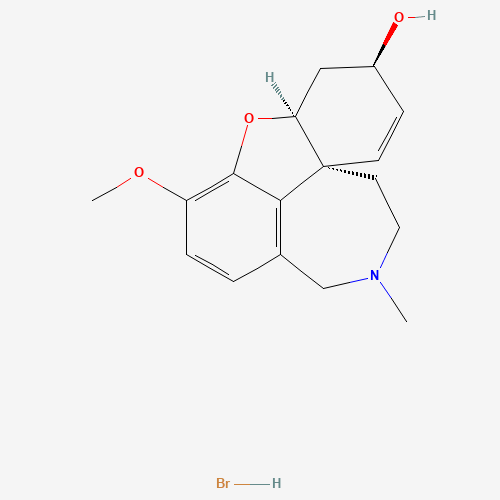| Pharmaceutical Information |
| Drug Name |
Galantamine hydrobromide |
| Drug ID |
BADD_D00997 |
| Description |
Galantamine is a tertiary alkaloid and reversible, competitive inhibitor of the acetylcholinesterase (AChE) enzyme, which is a widely studied therapeutic target used in the treatment of Alzheimer's disease.[A1018] First characterized in the early 1950s, galantamine is a tertiary alkaloid that was extracted from botanical sources, such as _Galanthus nivalis_.[A201968] Galantamine was first studied in paralytic and neuropathic conditions, such as myopathies and postpolio paralytic conditions, and for reversal of neuromuscular blockade.[A182993,A201968] Following the discovery of its AChE-inhibiting properties, the cognitive effects of galantamine were studied in a wide variety of psychiatric disorders such as mild cognitive impairment, cognitive impairment in schizophrenia and bipolar disorder, and autism; however, re-development of the drug for Alzheimer’s disease did not commence until the early 1990s due to difficulties in extraction and synthesis.[A201968] Galantamine blocks the breakdown of acetylcholine in the synaptic cleft, thereby increasing acetylcholine neurotransmission. It also acts as an allosteric modulator of the nicotinic receptor, giving its dual mechanism of action clinical significance.[A182993]
The drug was approved by the FDA in 2001 for the treatment of mild to moderate dementia of the Alzheimer's type. As Alzheimer's disease is a progressive neurodegenerative disorder, galantamine is not known to alter the course of the underlying dementing process. Galantamine works to block the enzyme responsible for the breakdown of acetylcholine in the synaptic cleft, thereby enhancing cholinergic neuron function and signalling. Under this hypothesized mechanism of action, the therapeutic effects of galantamine may decrease as the disease progression advances and fewer cholinergic neurons remain functionally intact.[L13571] It is therefore not considered to be a disease-modifying drug.[A203558] Galantamine is marketed under the brand name Razadyne, and is available as oral immediate- and extended-release tablets and solution.[L13571] |
| Indications and Usage |
Galantamine is indicated for the treatment of mild to moderate dementia of the Alzheimer’s type.[L13571] |
| Marketing Status |
approved |
| ATC Code |
N06DA04 |
| DrugBank ID |
DB00674
|
| KEGG ID |
D02173
|
| MeSH ID |
D005702
|
| PubChem ID |
121587
|
| TTD Drug ID |
D0R9VR
|
| NDC Product Code |
43353-984; 47335-835; 0054-0137; 47335-836; 63629-2364; 12578-890; 63629-2363; 63629-2365; 65862-487; 47335-837; 55111-081; 65372-1138; 65129-1113 |
| UNII |
MJ4PTD2VVW
|
| Synonyms |
Galantamine | Lycoremine | Galantamin | Galanthamine | Nivaline | Nivalin | Razadyne | Reminyl | Galanthamine Hydrobromide |
|
| Chemical Information |
| Molecular Formula |
C17H22BrNO3 |
| CAS Registry Number |
1953-04-4 |
| SMILES |
CN1CCC23C=CC(CC2OC4=C(C=CC(=C34)C1)OC)O.Br |
| Chemical Structure |

|
|
| ADRs Induced by Drug |
|
|
*The priority for ADR severity classification is based on FAERS assessment, followed by the most severe level in CTCAE rating. If neither is available, it will be displayed as 'Not available'.
**The 'Not Available' level is hidden by default and can be restored by clicking on the legend twice..
|
|
|

